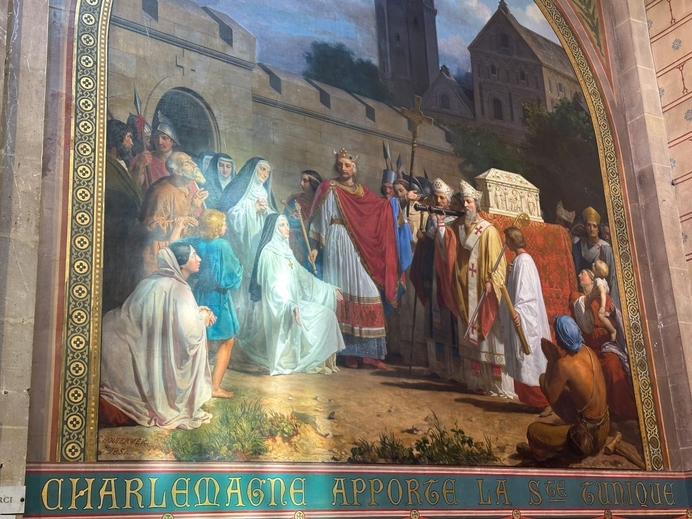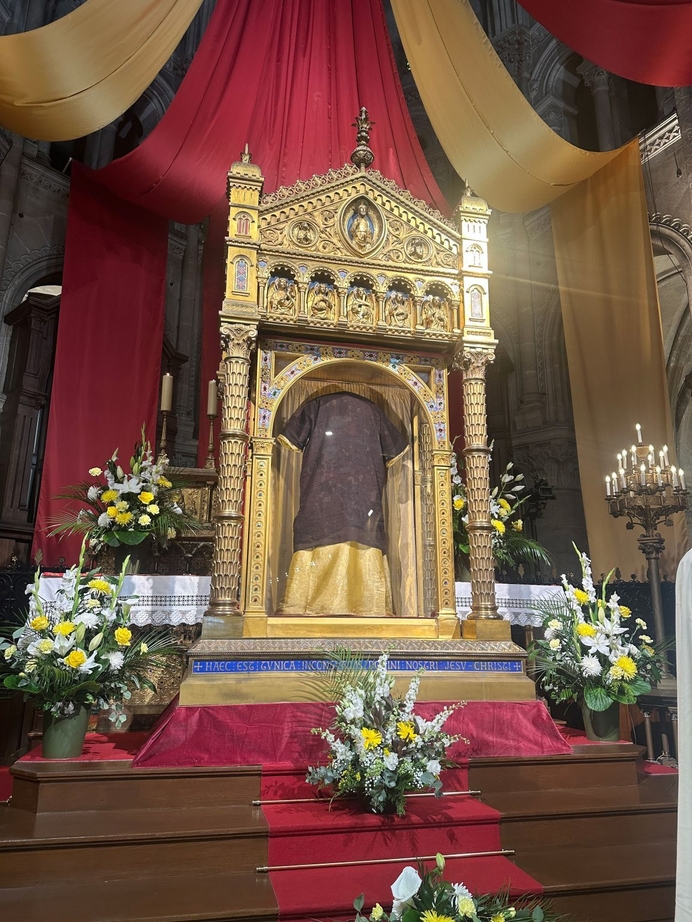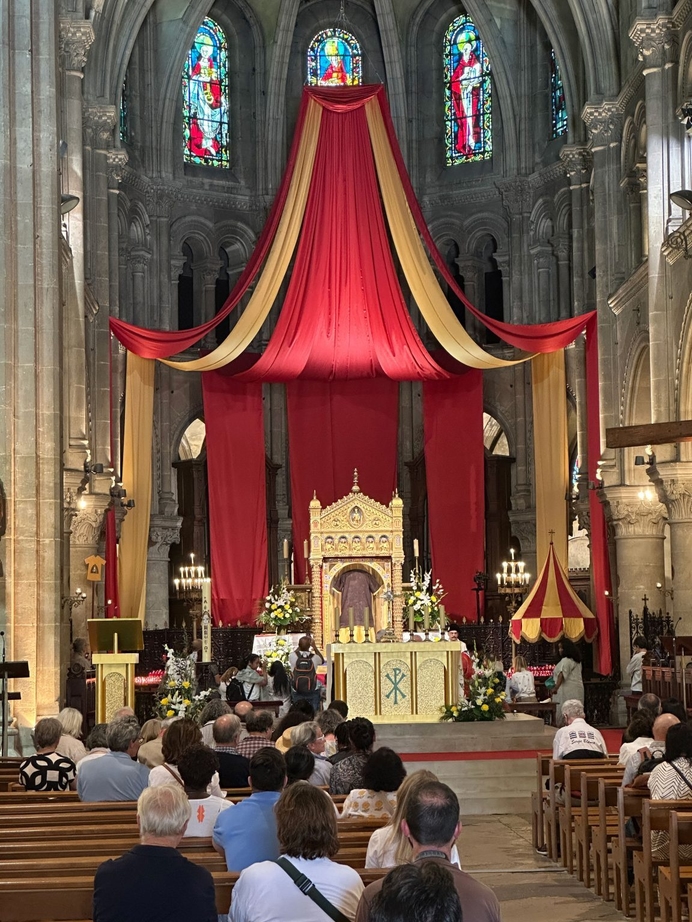
Nearly Half a Million Pilgrims Visit the Holy Tunic of Argenteuil Near Paris
From April 18 to May 11, a rare exposition of the Holy Tunic of Argenteuil—better known as the “seamless garment” of Our Lord Jesus Christ—took place at the Basilica of Saint Denis of Argenteuil, a few miles northwest of Paris. The exposition, held to commemorate the 2025 Jubilee, drew 400,000 visitors, double the number from the previous exposition in 2016. Dozens of cardinals and bishops visited, underlining the importance of the event, in addition to pilgrims’ groups from around the world. Although the Tunic is one of the most precious relics in Christendom, it is not nearly as well-known outside of France as the Shroud of Turin, to which it is often compared. The 2025 exposition, however, is giving the relic new visibility and serving as an occasion for graces and conversions at a moment when France and the Christian West are facing unprecedented crises.
It is one of the few relics explicitly mentioned in the four Gospels, with the most detail given by Saint John:
“When the soldiers had crucified Jesus, they took his clothes and divided them into four shares, a share for each soldier. They also took his tunic, but the tunic was seamless, woven in one piece from the top down. So they said to one another, ‘Let’s not tear it, but cast lots for it to see whose it will be,’ in order that the passage of scripture might be fulfilled [that says]: ‘They divided my garments among them, and for my vesture they cast lots.’” (John 19:23-24)
Don't miss anything and sign up for the newsletter!
The Tunic is a purplish brown wool cloak measuring 48 inches tall (originally 58 inches, most likely), 36 inches wide under the arms and 51 inches across the chest. It has been heavily damaged over the centuries due to wars and revolutions.
The earliest documentation of the Tunic’s existence comes from the sixth century when it was venerated in Jerusalem. It was taken as booty by the Persian King Chosroes II after his conquest of the Holy City, then returned to the Byzantine Emperor in 630, escaping the Arab conquest of the Holy Land.
The Byzantine Empress Irene sent a diplomatic mission to the court of Charlemagne in 801 to negotiate a possible marriage between the two. As a personal gift, she sent the seamless garment, which symbolized the desire to see both Eastern and Western Christendom reunited. In 813, Charlemagne gave the relic to the Benedictine convent of Argenteuil, just outside Paris, where his daughter Theodrada was abbess. The Tunic has remained in Argenteuil ever since.

The Byzantine Empress Irene sent a diplomatic mission to the court of Charlemagne in 801 to negotiate a possible marriage between the two. As a personal gift, she sent the seamless garment, which symbolized the desire to see both Eastern and Western Christendom reunited.(scene depicted in painting)
Over the centuries, the Holy Tunic suffered many misfortunes. In 885, it was hidden away to protect it from Viking raids and forgotten until it was rediscovered in 1152. Its first exposition for public veneration was in 1156 in the presence of King Louis VII. During the Wars of Religion of the sixteenth century, it was hidden again, after which it was the subject of many public processions and venerations. However, its most tragic episode occurred in 1793 during the Reign of Terror of the French Revolution when the parish priest of Argenteuil decided to cut up the Tunic into numerous pieces to “save” it, burying some of the pieces in the parish garden while distributing others.
The nineteenth century saw the Tunic reconstituted and the rebirth of its public veneration. It also marked the beginning of the scientific study of the Tunic, which over the years has only served to strengthen the Tunic’s claims to authenticity.
The first tests done in 1892 determined that, despite having been cut into pieces during the Reign of Terror, the wool fabric was originally seamless and that it matched the weave and style of a first-century garment from Palestine. These scientists also determined that it was covered with several human bloodstains. Tests done in 1997 by André Marion, director of the Institut d’Optique d’Orsay, showed that the bloodstains correspond to a wearer who carried a heavy object and match up perfectly with the wounds found on the Shroud of Turin.

The Seamless Garment of Our Lord
Skeptics point to the two Carbon-14 tests. The first dated the Tunic to between 530 and 650 and the second to 670 to 880. However, the large margin of error of 350 years between the two tests serves more to illustrate the limitations of Carbon-14 dating. The Tunic has been heavily contaminated over the centuries, having been buried underground, hidden in walls and soaked in chemicals to preserve and protect it. It might be impossible to completely clean the fabric and reliably date the cloth.
Meanwhile, other scientific experiments continue to point to the Tunic’s authenticity. In 2005, tests revealed that the Tunic contained pollen grains from numerous plants only found in the Holy Land, many of which are also found on the Shroud of Turin. In addition, the blood found on the Tunic was discovered to be type AB, which is the rarest blood type in the world. It is virtually unknown among the native peoples of Europe but relatively more common among Middle Eastern peoples. AB is also the same blood type found on the Shroud, the Sudarium of Oviedo and many Eucharistic miracles such as that of Lanciano, Italy. While not decisive, these tests show that there is more evidence than ever pointing to the Shroud’s authenticity.
French historian Jean-Christian Petitfils, author of La Sainte Tunique d’Argenteuil: Authentique relique de la Passion du Christ (The Holy Tunic of Argenteuil: Authentic Relic of Christ’s Passion) and expert on the history of the relic, believes that “doubt about the authenticity of the Holy Tunic of Argenteuil no longer exists.”
If the first mention of the Holy Tunic in the Gospel was accompanied by a miracle (the cure of the woman with the issue of blood), it is no surprise that miracles linked to the Holy Tunic have continued to take place until today. In 1151, shortly after its rediscovery, Abbé Suger of the monastery of Saint Denis suggested to Gauslens de Vierzy, the Bishop of Soissons, to make a pilgrimage to the Holy Tunic. The bishop, who was suffering from a severe fever, touched the relic and was immediately cured, according to the testimony of witnesses.
Historians record several cases of stillborn babies who were brought back to life upon touching the Tunic. In 1620, a pandemic ended after the Holy Tunic was carried in procession. From 1673 to 1746, there were no fewer than 11 ecclesiastical inquiries into many dozens of miraculous cures attributed to the Holy Tunic. On July 16, 1673, a twenty-year-old woman named Catherine Potel, who had lost the use of her legs for seven years, was brought before the Holy Tunic in a special chair. She was immediately cured, an event described in signed testimony from the master surgeon of Argenteuil. Many other documented miracles continued to take place right up into the nineteenth and twentieth centuries.
But far more miraculous than the physical cures are the spiritual ones. Countless visitors to the Holy Tunic have been touched by grace and experienced conversions, a spirit of repentance, and a rebirth of fervor. Many non-Catholics, including Muslims—whose numbers are growing in France—have embraced Catholicism in part thanks to the graces received through the relic. Indeed, by all accounts, the Holy Spirit is granting graces and touching souls in the firstborn daughter of the Church more than at any time in recent memory.

Crowds adoring the Holy Tunic
The numbers are revealing. The previous exposition held for the 2016 Year of Mercy received approximately 200,000 pilgrims. The 2025 exposition was estimated to attract 400,000, a remarkable increase in only nine years. This increase is happening alongside a steep rise in adult and teenage baptisms in France. In 2025, more than 17,000 adults and teenagers were baptized and received into the Church at Easter, a 45% increase from 2024, a 90% increase from 2023, and 160% since 2015. Even more striking is that these conversions largely occur among the young. French adults aged 18-25 represent 45% of all adult conversions.
While the overall numbers are much smaller than the number of those who leave the Church, it nevertheless points to a deep reality: in an increasingly uncertain world, many young adults in France (and around the world) are hungry for certainties, orthodoxy, and traditional spirituality found in the Catholic Church. That this is happening amid a moral crisis worse than any in history, and one that afflicts the Church hierarchy and faithful no less than non-Catholics, is a greater miracle than any physical cure.
